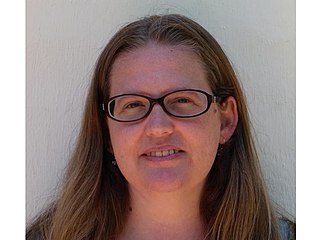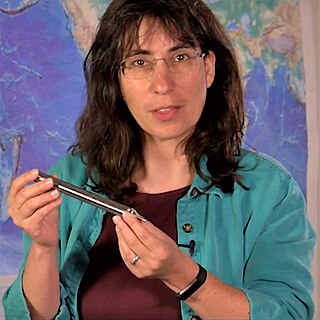Related Research Articles

Seismology is the scientific study of earthquakes and the generation and propagation of elastic waves through the Earth or other planetary bodies. It also includes studies of earthquake environmental effects such as tsunamis as well as diverse seismic sources such as volcanic, tectonic, glacial, fluvial, oceanic microseism, atmospheric, and artificial processes such as explosions and human activities. A related field that uses geology to infer information regarding past earthquakes is paleoseismology. A recording of Earth motion as a function of time, created by a seismograph is called a seismogram. A seismologist is a scientist works in basic or applied seismology.

Hiroo Kanamori is a Japanese-American seismologist who has made fundamental contributions to understanding the physics of earthquakes and the tectonic processes that cause them.

James O. Berkland was an American geologist who controversially claimed to be able to predict earthquakes, including the 1989 Loma Prieta earthquake and 1994 Northridge Earthquake and who popularized the idea that some people are earthquake sensitive. He was profiled in a popular 2006 book as The Man Who Predicts Earthquakes. The book includes a chapter that notes "Many of Berkland's theories--based on tides, moons, disoriented pets, lost cats and dogs, and magnetic field changes--were factors in the great Indian Ocean quake-tsunami disaster on December 26, 2004." but neither his methods nor his predictions have been published in any scientific journals for peer review. His results have been disputed by peers, with other scientists going so far as calling him a crank and a clown.

Keiiti Aki was a Japanese-American professor of Geophysics at the Massachusetts Institute of Technology (MIT), and then at the University of Southern California (USC), seismologist, author and mentor. He and Paul G. Richards coauthored "Quantitative Seismology: theory and methods".

Don Lynn Anderson was an American geophysicist who made significant contributions to the understanding of the origin, evolution, structure, and composition of Earth and other planets. An expert in numerous scientific disciplines, Anderson's work combined seismology, solid state physics, geochemistry and petrology to explain how the Earth works. Anderson was best known for his contributions to the understanding of the Earth's deep interior, and more recently, for the plate theory hypothesis that hotspots are the product of plate tectonics rather than narrow plumes emanating from the deep Earth. Anderson was Professor (Emeritus) of Geophysics in the Division of Geological and Planetary Sciences at the California Institute of Technology (Caltech). He received numerous awards from geophysical, geological and astronomical societies. In 1998 he was awarded the Crafoord Prize by the Royal Swedish Academy of Sciences along with Adam Dziewonski. Later that year, Anderson received the National Medal of Science. He held honorary doctorates from Rensselaer Polytechnic Institute and the University of Paris (Sorbonne), and served on numerous university advisory committees, including those at Harvard, Princeton, Yale, University of Chicago, Stanford, University of Paris, Purdue University, and Rice University. Anderson's wide-ranging research resulted in hundreds of published papers in the fields of planetary science, seismology, mineral physics, petrology, geochemistry, tectonics and the philosophy of science.
Susan Elizabeth Hough is a seismologist at the United States Geological Survey in Pasadena, California, and scientist in charge of the office. She has served as an editor and contributor for many journals and is a contributing editor to Geotimes Magazine. She is the author of five books, including Earthshaking Science (Princeton).

Lucile M. Jones is a seismologist and public voice for earthquake science and earthquake safety in California. One of the foremost and trusted public authorities on earthquakes, Jones is viewed by many in Southern California as "the Beyoncé of earthquakes" who is frequently called up on to provide information on recent earthquakes.
Wen Lianxing is a Chinese seismologist and geophysicist. He is a professor at Stony Brook University and the University of Science and Technology of China. He was awarded the James B. Macelwane Medal in 2003 and elected a fellow of the American Geophysical Union.
Peter Huybers is an American climate scientist, and Professor of Earth and Planetary Sciences at Harvard University, in the Department of Earth and Planetary Sciences.

Jasper A. Vrugt is a Dutch scientist/engineer/applied mathematician known for his work in the earth sciences: surface hydrology, soil physics, hydrogeophysics, hydrometeorology, and geophysics. Vrugt is an assistant professor at the University of California, Irvine and holds a joint appointment in the Department of Civil and Environmental Engineering and the Department of Earth System Science. He also holds a part-time appointment as associate professor at the University of Amsterdam, Faculty of Science (CGE).

Walter D. Mooney is a research seismologist and geophysicist at the United States Geological Survey (USGS), Menlo Park, California (1978–present). He was Chief of the USGS Branch of Seismology from 1994 to 1997.

Jeanne L. Hardebeck is an American research geophysicist studying earthquakes and seismology who has worked at the United States Geological Survey (USGS) since 2004. Hardebeck studies the state of stress and the strength of faults.
Richard Hugh Sibson is a New Zealand structural geologist and emeritus professor at the University of Otago, who has received numerous honors and awards for his work in the field of earthquake research. He has caused a 'fundamental shift' in the interpretation of the relationship between earthquakes and fault zone geology and on the origin of fault-hosted mineral deposits.
Maureen D. Long is an observational seismologist studying mantle and Mesosphere dynamics. She currently serves as a professor at Yale University within the Department of Geology and Geophysics.

Emily E. Brodsky is a Professor of Earth Sciences at the University of California, Santa Cruz. She studies the fundamental physical properties of earthquakes, as well as the seismology of volcanoes and landslides. In 2023, she was elected to the National Academy of Sciences.
Joan S. Gomberg is a research geophysicist at the United States Geological Survey. She serves as an adjunct professor at the University of Washington. She is interested in subduction zone science, and studies how earthquakes trigger each other and how faults can slip. Gomberg is a Fellow of the American Geophysical Union. She was the first person to demonstrate how dynamic stress associated with seismic waves can trigger other earthquakes.
Miaki Ishii is a seismologist and Professor of Earth and Planetary Sciences at Harvard University.
Elizabeth Scott Cochran is a seismologist known for her work on early warning systems for earthquakes and human-induced earthquakes.
Kate E. Allstadt is a geologist and seismologist employed by the U.S. Geological Survey (USGS) who works out of Golden, Colorado. She is a self-described "present-day geologist" for her interest in connections between geology of the Pacific Northwest and the people in its local communities. She is a published expert on the 2014 Oso landslide.
Seth Avram Stein is an American geophysicist with an international reputation for his research in plate tectonics, seismology, and space geodesy. He has also done important work in public policy for coping with earthquake hazards.
References
- ↑ "UW researchers helping region get ready for the next Big One | UW Today". www.washington.edu. Retrieved 2016-10-26.
- ↑ "Macelwane medal". Apr 21, 1994. Archived from the original on September 7, 2004. Retrieved 2007-04-11.
- ↑ "John Vidale" . Retrieved 2018-04-30.
- ↑ "Wired". May 25, 2004. Retrieved 2007-04-11.
- ↑ "India's national newspaper". The Hindu . Chennai, India. November 2, 2006. Archived from the original on October 1, 2007. Retrieved 2007-04-11.
- ↑ "American Scientist". Sep 2002. Archived from the original on October 7, 2007. Retrieved 2007-04-11.
- ↑ "Science Now". May 25, 2000. Archived from the original on September 12, 2004. Retrieved 2007-04-11.
- ↑ "Science Daily Article". Feb 3, 2003. Retrieved 2007-04-11.
- ↑ "Science Daily". Feb 12, 1998. Retrieved 2007-04-11.